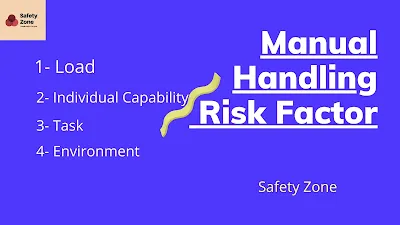MANUAL HANDLING RISK ASSESSMENT
Mechanical handling of loads practically does not exist and manual handling is generally limited to small weights and occasional handling, its most common incidence being non-teaching personnel.
MANUAL HANDLING DEFINITION
Load: Any object capable of being moved.
Handling or manual handling of loads: Any operation of transporting a load by one or more workers, by own effort such as lifting, placing, pushing, pulling, transporting or moving actions is called manual handling.
Handling or mechanical handling of loads: Set of handling operations (lifting, transport, unloading) or change of location of any material by mechanical methods, that is, by handling equipment, such as self-propelled forklifts, overhead cranes, and conveyors.
MANUAL HANDLING RISK
- Physical fatigue
- Injuries that can occur immediately.
- Accumulation of small, apparently unimportant injuries, leads to chronic injuries.
- The most frequent injuries are:
- Bruises
- Cuts and wounds.
- Fractures
- Skeletal muscle injuries.
They can occur in any area of the body, but the upper limbs and the back are more sensitive, especially in the dorsal-lumbar area.
The range of dorsal-lumbar injuries can vary from low back pain to alterations of the intervertebral discs (herniated discs) or even vertebral fractures due to overexertion.
Risk factors manual handling:
1. Load:
T Manual handling of a load can present a risk, in particular dorsal-lumbar, in the following cases:
- As a general indication, the maximum recommended weight not to exceed (under ideal handling conditions) is 25 kg.
- If it is bulky or difficult to hold.
- If it is in an unstable balance or its content is at risk of displacement.
- If the load, due to its external appearance or its consistency may cause injury to the worker, in particular in the event of an impact.
2. Task:
A physical effort can involve risk, particularly in the lower lumbar region, in the following cases:
- If it is too intense.
- If it can only be done by torsion or bending movement of the trunk.
- If it can cause a sudden movement of the load.
- If performed while the body is in an unstable position.
- If it is about raising or lowering the load with the need to modify the grip.
- Too frequent or prolonged physical efforts involving the spine in particular.
 |
| manual pallet truck |
3. Environment:
- Insufficient period of physiological rest or recovery.
- If the free space, especially vertical is insufficient for the exercise of the activity in question.
- If the ground is uneven and, therefore, can lead to tripping or is slippery for the footwear worn by the worker.
- If the situation or the work environment does not allow the worker to manually handle loads at a safe height and in a correct posture.
- If the floor or the work surface has unevenness that implies the handling of the load at different levels.
- If the ground or the fulcrum is unstable.
- If the temperature, humidity or air circulation is inadequate.
- If the lighting is not adequate.
- Lifting, lowering or transporting distances too great.
4. Individual factors
Following constitute individual risk factors:
- Lack of physical fitness to perform the tasks in question.
- The inappropriateness of the clothes, footwear or other personal effects worn by the worker.
- Insufficient or inadequate knowledge or training.
- The previous existence of dorsal-lumbar pathology.
 |
| electric pallet truck |
As a general rule, it is preferable to handle loads close to the body, at a height between elbows and knuckles, as this reduces stress on the lower back. If the loads to be handled are on or near the ground, load handling techniques that allow the leg muscles to be used more than the back muscles will be used.
Manual Handling Safety Tips
Plan:
- Use the necessary mechanical aids, whenever possible.
- If there are no indications, observe the load carefully, paying special attention to its shape and size, possible weight, grip areas, possible dangerous points, etc.
- Seek help from others if the weight of the load is excessive or uncomfortable postures need to be adopted while lifting.
- Place the feet in a stable and balanced posture for the lift, spreading the feet to a width similar to that of the shoulders.
 |
| safe manual handling technique |
Lifting posture:
Bend your legs, keep your back straight at all times, and keep your chin tucked in. Do not over-bend the knees. Do not twist the trunk or adopt forced postures.
Lifting:
Smooth lifting, without giving sudden jerks.
Avoid twists.
Load attached to the body.
Deposit the load:
If the lift is from the ground to a significant height, for example, shoulder height or higher, support the load halfway to be able to change the grip.
Deposit the load and then adjust it if necessary.



